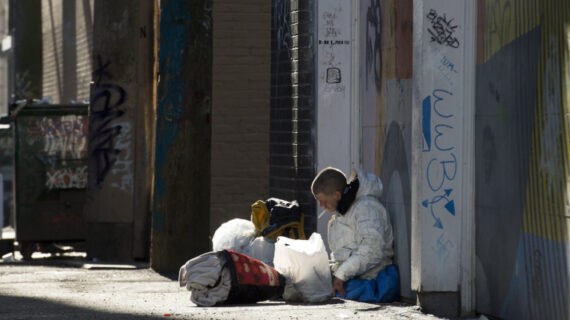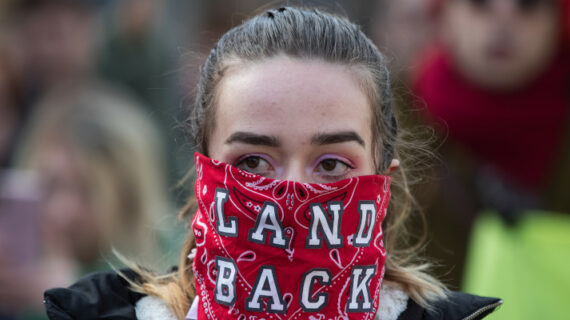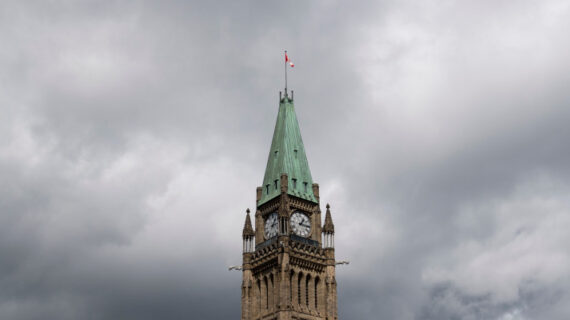In 2015, newly minted Prime Minister Justin Trudeau declared Canada was finally “back” on the world stage. But many argue that in the last decade, Canada’s international voice has only continued to weaken, and today is little more than a whisper. We do not wield the same authority or command the same respect as we did generations ago.
After countless trips abroad, Matthew Fisher, Canada’s longest-serving foreign correspondent admitted, “There is no country in the world that does less and says more than Canada.” Was he on to something, or exaggerating? What’s happened? Who’s to blame? And what’s a multilateral-minded middle power to do?
This past Tuesday, The Hub’s Managing Editor Harrison Lowman was invited to speak at Toronto’s Royal Canadian Military Institute on the subject of Canada’s waning international influence.
Below is an excerpt from his speech, entitled, “Has Canada Lost Its Place on the World Stage?”
Hub readers can watch the entire speech, along with its lively QandA here:
On August 15, 2021, Taliban fighters stunned the world, streaming into Kabul, Afghanistan like a swarm of locusts. They spread through the city on dusty pick-up trucks, stormed into government buildings, past streets NATO forces had died defending. They occupied the capital at lightning speed. Barely a shot was fired.
In mere hours, Kabul was draped with their black flags. They had returned to power 20 years after being banished.
A humanitarian who worked in women’s health care in the country was texting me from inside a bunker. I asked if she was okay. She told me, “I am safe. Afghans are not…It’s insane.”
An Afghan journalist who grew up in Kabul and who had been covering the war for two decades was gathering his family to flee. He told me he had just witnessed “the massacre of [his] dreams.” He told me he and his children ran for their lives.
Western ambassadors had been preparing for this day, but they could not have imagined it would come so soon. They were scrambling. The British ambassador Sir Laurie Bristow sounded like he was going down with the ship:
“We’ll put everything we can on this for the next few days, trying to get out everyone who we need to get to safety as soon as we can,” he assured those listening. He would go on to evacuate thousands.
The Americans stayed. The French ambassador stayed too. France sent commandos to gather French nationals and Afghan families and get them to military planes.
The Ukrainians, who were on the verge of their own invasion, chartered a bus, which drove through live firefights to get their people, along with Afghans who had helped Canada, out of harm’s way.
Where was Canada?
Gone. Missing in action. We were reportedly one of, if not the first major embassy to evacuate.
Within no time, long-bearded guerilla fighters were happily traipsing through our abandoned embassy. Past piles of empty wine bottles, and our painting of an Afghan girl learning to read, beneath a red maple leaf. It was a bad look for our supposed feminist foreign policy.
Where was the Canadian ambassador to Afghanistan, Reid Sirrs?
He had apparently boarded a half-empty RCAF military plane and taken off to safety…one of only two Canadian military aircraft to flee the city.
If Mr. Sirrs had looked down as he left Kabul airspace, he may have been able to make out the more than 1,000 Canadian citizens and interpreters who helped our armed forces during our 13-year mission.
“We all saw on TV, it was two planes after ours that the people were hanging off the airplane when people fell off it,” said Sirrs later on, reported by Blacklock’s Reporter. “So, it was quite close for us.”
For us. Mr. Sirrs?
Thousands of terrified people were stranded. What notice did our citizens and allies get who had been left behind? It turns out that all they initially received were text messages from Immigration, Refugees and Citizenship Canada. They were instructed—in English only—to travel on their own with no escorts (our soldiers, military advisors, and diplomats were gone, you see) and sneak past Taliban fighters, through a churning, muddy and bloody sea of desperate civilians, to the airport. They were later told that, if they made it to the airport gates, they should be wearing something red and shout out “Canada” and hope a soldier heard them. In the coming weeks, it would become clear that it was really up to Canadian veterans to volunteer to get translators and their families out of the country. Not our government.
This was a complete abdication of duty. We betrayed these people. And we should be ashamed of our country.
Canadian ambassador to Afghanistan Reid Sirrs would be quietly reassigned to a posting in Argentina. He and his staff would be honoured with a ceremony and a $10,000 plaque that now sits outside Global Affairs Canada. It commemorates what our federal government claims was our amazing evacuation of Afghans and embassy staff. Astonishingly, it reads, “This plaque pays tribute to all the government of Canada employees who contributed to this heroic effort.” Sirrs’ LinkedIn profile currently reads that he has skills when it comes to “managing during times of crisis.”
In Kyiv, Ukraine, on Feb. 12, 2022, 12 whole days before Russian troops fired a shot, Canada would again be one of the first to leave. We allegedly hold the title of being the only G7 country to immediately suspend our diplomatic presence in Kyiv at the time. It then took almost 90 days for us to then only partially re-open Canada’s embassy.
In Israel, this past October, as Hamas terrorists burst into Israeli kibbutzim slaughtering men, women and children, Canadian citizens on the ground who attempted to contact the Canadian embassy there were met by a voicemail advising them the embassy was closed for the Thanksgiving long weekend. As reported by Matt Gurney, they were initially directed to an emergency hotline…in Ottawa.
It seems when the going gets tough, Canada gets going.

An international reputation running on fumes
All of these examples are symptoms of a disease this country has been suffering from for decades. And believe me, we are sick and in need of a cure.
It is now 2024. And we are still relying on the Pearsonian reputation of Canada built in the 1960s.
Can you guess how many Canadians we currently have taking part in UN peacekeeping operations? The present government, which insisted in 2015 that Canada “is back,” would have you believe there are hundreds of Canadian blue berets currently stationed across the globe.
The real answer is 57. In 1992 it was 3,285.
In 2024, Canada’s reputation is running on fumes. And the world it was built on? That world no longer exists. No matter how much we pretend it still exists. It doesn’t.
“Free riders.” “Not pulling its weight.” “Risk-averse.” “Unreliable.” “Not fit for purpose.”
These are the words we increasingly see attached to our country’s name; whispered in the corners of international conferences.
Not only that, you now hear that we are, “Preachy” or “Act like we are morally superior.”
Former Liberal deputy prime minister and foreign affairs minister John Manley recently had this to say:
“We seem to have decided that we would rather carry a soapbox with us and get up on it and tell people how they need to do things differently, rather than finding ways to insinuate ourselves into these many complex and difficult situations…”
You have all heard the expression, walk softly and carry a big stick. Canadian academic Denis Stairs says Canadian foreign policy is more akin to “speak loudly and carry a bent twig.”
Before he passed, Matthew Fisher, Canada’s longest-serving foreign affairs correspondent used to tell me, “There is no country in the world that does less and says more than Canada.”
It all begs the question: on the world stage, are we a serious country, or not a serious country?
A frayed rules-based international order
In an interview with the Toronto Star last month, Prime Minister Trudeau stressed that one of his biggest priorities was “standing up for the international rules-based order.”
A few weeks later Donald Trump, possibly the next U.S. president, spouted off at a rally, quoting an unnamed world leader who asked him about NATO spending and collective defence saying, “Well sir, if we don’t pay, and we’re attacked by Russia, will you protect us?”.
What did Trump say his response to this world leader was?:
“You didn’t pay? You’re delinquent? No, I would not protect you. In fact, I would encourage them [Russia] to do whatever the hell they want. You gotta pay.”
Today, the rules-based international order that has sustained us for 75 years is on life support. It is hanging on a thread. And it cannot be wished back into being.
“The foundations of the world order are being shaken to their core,” admitted U.K. Defence Secretary Grant Shapps at the beginning of this year.
In its place we see authoritarian leaders emerging, and the multilateral institutions (the UN, WTO..etc) where Canada’s soft voice was once amplified becoming increasingly irrelevant.
As Ben Rowswell, a convener at the Network for Democratic Solidarity, and a former Canadian ambassador and diplomat recently told me, these organizations are now not much more than “paper exercises.”
Meanwhile, strong illiberal authoritarian leaders of powerful countries (Russia, China, Iran) have formed their old boys’ clubs of bullies on a parallel plane, outside multilateral institutions. And they don’t care about the rules.
Putin has started a European war. China is building artificial islands in the contested South China Sea and eyeing Taiwan. Iran is fomenting unrest across the Middle East.
It’s “a knife fight,” says Rowswell.
“The world has suddenly become stranger, more dangerous, more complicated, and we’re beginning to feel those reverberations in Canada to a much greater extent,” David Mulroney, Canada’s former ambassador to China told me recently. “But the government has simply not responded to that.”
It has now come to the point where even our traditional allies are overlooking us as they assemble alliances. The world no longer immediately says, “We want more Canada.”
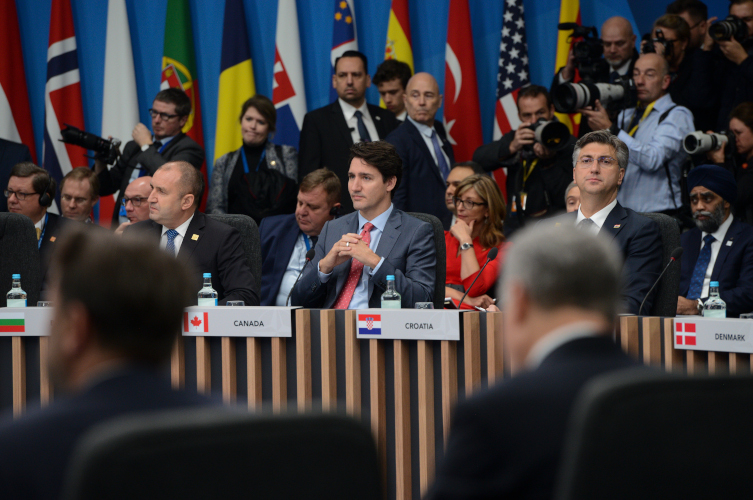
A neglected Canadian military
Canada’s armed forces are neglected, ill-equipped, and fed up.
“We are an irrelevant military force,” summarized retired Lieut. Gen. Mike Day, a former Canadian special forces commander and chief strategic planner for the Canadian Armed Forces.
Other former high-ranking members of the forces are furiously writing opinion editorials claiming our military is on the brink of collapse.
Meanwhile, almost without precedent, we are seeing soldiers who are still actively serving, taking risks by voicing their major concerns publicly.
Vice-Admiral Angus Topshee, commander of the Royal Canadian Navy, published a video on YouTube explaining the dire state of our navy. He said his team “faces some very serious challenges” that could mean they “fail to meet” their commitments. He bemoaned the fact that only one of the Canadian Navy’s new offshore patrol vessels could be deployed at a time because of staff shortages.
Vice-Admiral Bob Auchterlonie, commander of the Canadian Joint Operations Command, also publicly expressed how soldiers are increasingly being relied on to respond to Canadian natural disasters which are not in their job descriptions.
The current defence minister is working off a mandate letter penned three years ago. There was supposed to be what’s referred to as a “defence update” (which names the military’s long-term goals and the equipment needed) delivered in fall 2022. But it’s AWOL and still hasn’t happened. We haven’t had an update since 2017. Consider for a moment how much the world has changed since 2017.
We are arming men and women, who we are sending into harm’s way, with obsolete equipment.
“Their equipment has been relegated to sort of broken equipment parked by the fence,” says former chief of defence staff Rick Hillier. “Our fighting ships are on limitations to the speed that they can sail or the waves that they can sail in…And so, I feel sorry for the men and women who are serving there right now.”
Last year, I reported on some of Canada’s most egregious military equipment mishaps. A selection of what I found:
- Our soldiers have been using WW2-era Browning 9mm handguns as their standard-issue sidearm. We have been trying to replace them for more than a decade.
- We only retired the 114-year-old Lee Enfield rifle from frontline service a few years ago. We were the last national military in the world to do so. We were using a version of this rifle in the Boer War!
- Canada’s Victoria-class submarines were already second-hand when we purchased them in the 1990s. They have been breaking down and barely making it out to sea ever since. And we apparently need to use them into the 2030s.
- The notorious Sea King helicopters were flying for 55 years before they were replaced.
- The process of replacing our ancient fleet of CF-18 fighter aircraft took 12 years. They’re approaching 40 years old. The grandfathers of the people flying our fighter jets could have flown the same planes. My own grandfather, a journalist covering the forces, flew in the first one delivered to Canada. We are now apparently going to re-equip Canadian squadrons with the F-35. Who knows when?
Others disagree with all this. They assure me our military is not on the verge of collapse. That we should take the advice of retired generals calling for billions more in spending with a big grain of salt, as they are often working as consultants for defence companies. These critics will also tell you that calls for much more defence spending (which they often say comes at the expense of social services) are really just fear-mongering.
“It’s a bottomless pit. There’s never enough money for the defence establishment,” Peggy Mason, president of the Rideau Institute on International Affairs and a former Canadian ambassador for disarmament to the UN, told me. “And yet DND cannot even spend all the money it gets now—to the tune of $1-2 billion per year.”
“The Department of National Defence will always say it needs more money. And there’s a lot of hype that accompanies that,” veteran Ottawa Citizen defence reporter David Pugliese added.
NATO spending
Our current NATO contributions sit at about 1.38 percent of our GDP, a far cry from our two percent promise. Ignoring that, Prime Minister Trudeau reportedly privately told NATO officials Canada would never hit our spending target.
Rowswell characterized the prime minister’s admission as an example of his “utter incompetence on international security matters.”
We would need to spend around 30-40 percent more to reach the two percent commitment and then figure out a way for DND to even be able to absorb and allocate what would be a whopping $20 billion.
We currently rank 25th out of 30 NATO members when it comes to defence spending. But we’re around the sixth largest spender in terms of absolute dollars.
All this, and DND has apparently been told to cut $1 billion in funding by 2026.
Conservative leader Pierre Poilievre says if he wins office his government would “work toward” increasing military spending to two percent of our GDP.
He says he’ll do it by slashing “back-office bureaucracy,” stopping corruption in procurement, and cutting foreign aid.
But, our contributions to official development assistance (aid to developing countries) have “collapsed” already says Rowswell. Under this government it’s reached historically low levels.
And no government seems to be immune from ballooning procurement costs.
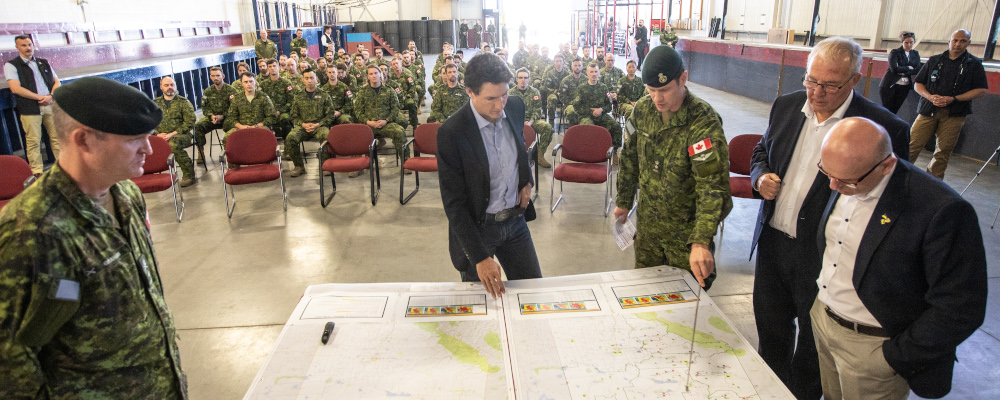
Recruitment, retention, and diversity
If all this were not enough, there are critical recruitment and retention issues. The armed forces are currently staring down a shortage of 16,000 troops. Among those we need most urgently are medical officers, naval operators, aviation specialists, communications experts, and technical tradespeople.
We have all heard of the raft of sexual misconduct scandals, some involving more than a dozen of Canada’s military top brass.
And a December 2023 report from Statistics Canada suggests the problem only appears to be getting worse.
In 2018, 1.6 percent of CAF personnel said they were sexually assaulted by another service member. Today it’s 3.5 percent.
Not to mention struggles diversifying the force, which is overwhelmingly white and male. 71 percent of our military are white males. For comparison, the civilian workforce is about 39 percent. Sixteen percent of CAF members are female. That number is supposed to be 25 percent by 2026. But one must wonder how realistic this is and whether there is a natural ceiling.
The military is facing real internal threats here that run the risk of becoming existential.
A professional Canadian military cannot function if its leaders and servicepeople are complicit in preying on the few female soldiers in its ranks.
A professional Canadian military is not sustainable if it can’t attract people who are not white when the Canadian population is increasingly not white.
We must think of solutions.
Soldiers fighting in the culture war
The current government thinks much of the solution involves deploying an arsenal of left-wing identity politics weaponry. Today, soldiers aren’t just fighting in actual wars, they are increasingly fighting in the culture wars.
The Canadian Military Journal, the official peer-reviewed academic journal of the Canadian Armed Forces, tasked with improving the development of soldiers, recently ran an issue highlighting what it described as a “feminist intersectional trauma-informed approach to reimagine and transform CAF culture.”
The general thrust was that the military is inherently racist, colonialist, patriarchal, and oppressive and needed to be torn down and rebuilt from the ground up.
“Racism in Canada is not a glitch in the system; it is the system. Colonialism and intersecting systems such as patriarchy, heteronormativity and ableism constitute the root causes of inequality within Canada,” wrote one contributor.
Another called out the military’s “violence and aggression, institutional unity and hierarchy.”
Violence. A formal collective comradery. Ranks. Is this not quite literally the point of all armies since we assembled in groups of cavemen to throw rocks at one another? Is the ultimate purpose of soldiers not to practice violence and aggression in defence of their country, and when necessary, kill other people?
An anonymous senior member of the Forces told the National Post that the Trudeau government’s intense focus on “fulfilling social policy objectives” has come at the expense of battle readiness.
When she entered the role, the previous minister of national defence, Anita Anand, said her “top priority was to make sure everyone in the Forces feels safe and protected.” It raises an important question. Should the military’s top priority be to create soldiers who feel safe and protected? Or rather, is the paramount priority to create a highly trained military? One that is battle-ready. Ready to be put in harm’s way. Can both be our top objectives simultaneously?
The new inclusive approach has meant the introduction of anti-racism tool kits, gender-neutral uniforms, relaxing bans on face tattoos, lengthy beards, long hair, and bright hair dye.
But, I can assure you that those changes did not result in a stampede to recruitment centres of hordes of people with goatees and spider face tattoos.
While clearly not the main reason enlistment is so low, just pause for a moment and put yourself in the shoes of an 18-year-old Canadian young man who is considering enlisting.
Since he was around eight, he has been told by his own government that his country is a settler-colonial state, guilty of countless historical misdeeds, and complicit in various forms of genocide. He has been told by his department of defence that the military is a bastion of white supremacy and male supremacy.
Ask yourself if this would make you want to join that military and potentially sacrifice your life for that country.


